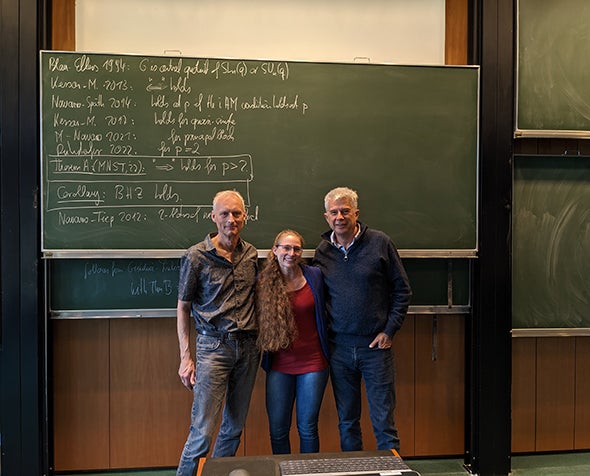DU Researcher Takes On Chronic Gut Disease
Assistant Professor Allegra Aron received a $250K grant from the Boettcher Foundation to study how microbes in the gut become harmful—and the surprising role that metals play.

The gastrointestinal tract is home to hundreds of species of bacteria—some harmful, some helpful, and some, known as pathobionts, that shift from harmless to problematic as a result of environmental changes. This shift can lead to chronic conditions like inflammatory bowel disease (IBD) and Crohn’s disease.
Allegra Aron, assistant professor in the Department of Chemistry and Biochemistry, is studying pathobionts and how to target these harmful microbes while preserving healthy ones. She recently received a $250,000 grant from the Boettcher Foundation as part of its Webb-Waring Biomedical Research Awards, a program which provides funding for early career investigators at Colorado research institutions and hospitals.
“In our gut, we have many, many microorganisms living together in a very complex ecosystem. And we also have microbiomes on our skin and in our nose, and elsewhere. Only now do we really have the tools to start to understand how some of the microbes communicate with other microbes,” Aron says.
They do so mainly through the production of small molecules, she explains. “An organism can exist in our microbiomes in a healthy state, but if we start eating a diet that's very different, or something else in the microbiome changes, then that organism might make a switch and start producing molecules or take over. Then, it can actually act more like a pathogen.”
Microbes like adherent invasive escherichia coli and proteus mirabilis can exist in the gut without causing disease, but, under certain conditions, they are linked to chronic gastrointestinal conditions.
Treating these conditions, which affect millions of Americans, is not as simple as getting rid of the bad bacteria. Current treatments often use broad-spectrum antibiotics, which don’t differentiate between good and bad microbes. Though effective, broad-spectrum antibiotics also wipe out healthy beneficial bacteria in the gut, leaving patients susceptible to secondary infections and other complications.
Taking advantage of metals in the microbiome
The key to selectively targeting harmful pathobionts, Aron says, is something surprisingly common: metals.
Microbes, like humans, need metals to carry out a variety of basic biological functions, from DNA replication to communication between cells.
“If you think about our own diet, we need metals, right? We need iron, we need zinc—if you take a multivitamin, there are typically metals in that,” Aron says. “And microbes also need metals, but in many environments, metal resources are scarce, and so the way microbes can access metals is by producing these very interesting small molecules that can bind to metals in their surrounding environment.”
Aron's research is exploring how the small, iron-binding molecules—known as siderophores—can influence the composition of the microbiome.
Previously, scientists have used siderophores to create a sort of “Trojan horse” effect, attaching them to antibiotics and tricking antibiotic-resistant microbes into absorbing the drug. The FDA-approved antibiotic cefiderocol, for example, employs this method to treat antibiotic-resistant urinary tract infections but relies on a chemically-synthesized siderophore that differs from the ones produced by the disease-causing microbe. The slight differences in shape and chemical makeup mean beneficial bacteria can also absorb and be killed by the drug. Aron is studying the chemical properties of siderophores produced natively in the gut, how bacteria absorb them and their potential use in more targeted "Trojan horse" antibiotics.
“This grant aims to understand how we might be able to take advantage of iron-binding molecules produced by the microbiome to modulate microbiome composition,” Aron says, “with the potential to bring it from diseased back to healthy.”
The research could have significant implications for IBD, Crohn’s disease and ulcerative colitis, among other chronic gastrointestinal conditions—paving the way for more targeted and effective treatments rather than resorting to broad-spectrum antibiotics.











